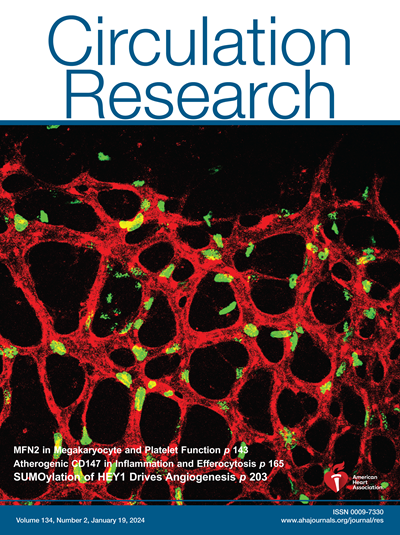IGFBP2 Mediates Human iPSC-Cardiomyocyte Proliferation in a Cellular Contact-Dependent Manner.
IF 16.2
1区 医学
Q1 CARDIAC & CARDIOVASCULAR SYSTEMS
引用次数: 0
Abstract
BACKGROUND Induction of cardiomyocyte proliferation in situ represents a promising strategy for myocardial regeneration following injury. However, cardiomyocytes possess intrinsic inhibitory mechanisms that attenuate pro-proliferative signaling and constrain their expansion. We hypothesized that cell-cell contact is a key suppressor of cardiomyocyte proliferation. We aimed to delineate the underlying molecular pathways to enable sustained proliferation in 3-dimensional contexts. METHODS Human induced pluripotent stem cell-derived cardiomyocytes (hiPSC-CMs) were cultured at varying plating densities to examine the impact of cell-cell contact on cell cycle activity. Phosphoproteomic profiling was performed in sparse versus dense cultures to identify signaling alterations. Conditioned media from sparse cultures were interrogated using a human growth factor array to identify secreted pro-proliferative factors. RESULTS hiPSC-CM proliferation increased proportionally with plating density until intercellular contacts were established, at which point proliferation was suppressed. Dense cultures exhibited enhanced adherens junction assembly, sarcomeric organization, and contractile function. Increased cell-cell contact in dense conditions attenuated nuclear translocation of β-catenin and reduced TCF/LEF transcriptional activity, providing a mechanistic basis for the reduced hiPSC-CM proliferation. Disruption of adherens junctions or sarcomere assembly via siRNA-mediated knockdown of N-cadherin or α-actinin, respectively, resulted in increased cell cycle activation of hiPSC-CMs, but this was not sufficient to drive division of hiPSC-CMs. Additional screening for putative secreted growth factors in the conditioned media from sparsely plated hiPSC-CMs revealed the enrichment of IGFBP2, which was sufficient to drive hiPSC-CM division in the presence of cell-cell contact in 3-dimensional constructs. CONCLUSIONS Our findings demonstrate that cell-cell contact inhibits hiPSC-CM proliferation through adherens junction formation, sarcomeric assembly, and reduced IGFBP2 secretion. Importantly, exogenous supplementation of IGFBP2 can overcome cell contact-mediated inhibition of hiPSC-CM proliferation and facilitate the growth of 3-dimensional cardiac tissue. These insights provide valuable implications for advancing cardiac tissue engineering and regenerative therapies.IGFBP2以细胞接触依赖的方式介导人ipsc -心肌细胞增殖。
背景:原位诱导心肌细胞增殖是损伤后心肌再生的一种很有前途的策略。然而,心肌细胞具有内在的抑制机制,可以减弱促增殖信号并限制其扩张。我们假设细胞间接触是抑制心肌细胞增殖的关键因素。我们的目的是描绘潜在的分子途径,使在三维环境中持续增殖。方法培养人诱导多能干细胞源性心肌细胞(hiPSC-CMs),观察细胞间接触对细胞周期活性的影响。在稀疏和密集培养中进行磷蛋白组学分析,以确定信号的改变。使用人生长因子阵列对稀疏培养的条件培养基进行询问,以确定分泌的促增殖因子。结果shipsc - cm的增殖随细胞密度的增加呈比例增加,直至细胞间接触建立,细胞间接触后增殖受到抑制。密集培养表现出粘附体连接组装、肌肉组织和收缩功能的增强。密集条件下细胞间接触增加,β-catenin核易位减弱,TCF/LEF转录活性降低,为hiPSC-CM增殖降低提供了机制基础。通过sirna介导的N-cadherin或α- actitin的敲低,分别破坏粘附体连接或肌节组装,导致hiPSC-CMs细胞周期激活增加,但这不足以驱动hiPSC-CMs的分裂。另外,在条件培养基中对来自疏膜hiPSC-CMs的推定分泌的生长因子进行筛选,发现IGFBP2的富集,这足以在三维结构中存在细胞-细胞接触的情况下驱动hiPSC-CM分裂。结论细胞间接触抑制hiPSC-CM的增殖,其机制是通过粘附连接的形成、肉瘤的组装和IGFBP2的分泌来实现的。重要的是,外源补充IGFBP2可以克服细胞接触介导的hiPSC-CM增殖抑制,促进三维心脏组织的生长。这些见解为推进心脏组织工程和再生治疗提供了有价值的启示。
本文章由计算机程序翻译,如有差异,请以英文原文为准。
求助全文
约1分钟内获得全文
求助全文
来源期刊

Circulation research
医学-外周血管病
CiteScore
29.60
自引率
2.00%
发文量
535
审稿时长
3-6 weeks
期刊介绍:
Circulation Research is a peer-reviewed journal that serves as a forum for the highest quality research in basic cardiovascular biology. The journal publishes studies that utilize state-of-the-art approaches to investigate mechanisms of human disease, as well as translational and clinical research that provide fundamental insights into the basis of disease and the mechanism of therapies.
Circulation Research has a broad audience that includes clinical and academic cardiologists, basic cardiovascular scientists, physiologists, cellular and molecular biologists, and cardiovascular pharmacologists. The journal aims to advance the understanding of cardiovascular biology and disease by disseminating cutting-edge research to these diverse communities.
In terms of indexing, Circulation Research is included in several prominent scientific databases, including BIOSIS, CAB Abstracts, Chemical Abstracts, Current Contents, EMBASE, and MEDLINE. This ensures that the journal's articles are easily discoverable and accessible to researchers in the field.
Overall, Circulation Research is a reputable publication that attracts high-quality research and provides a platform for the dissemination of important findings in basic cardiovascular biology and its translational and clinical applications.
 求助内容:
求助内容: 应助结果提醒方式:
应助结果提醒方式:


